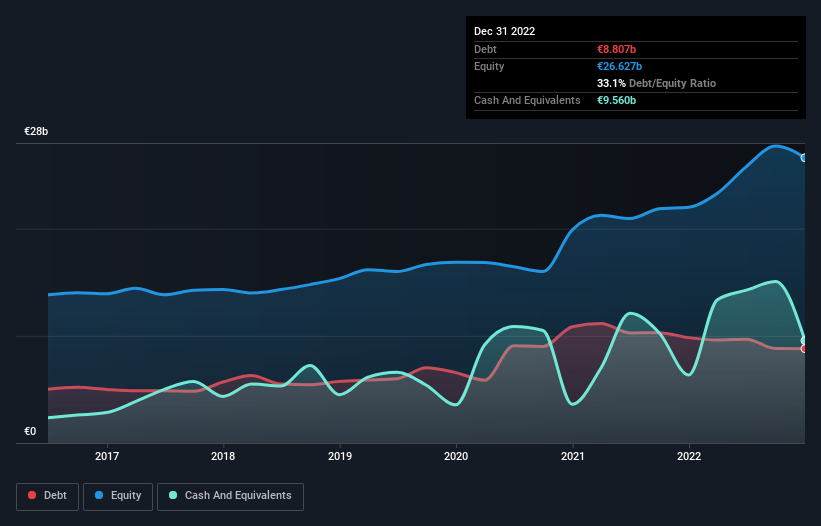David Iben put it well when he said, 'Volatility is not a risk we care about. What we care about is avoiding the permanent loss of capital.' So it might be obvious that you need to consider debt, when you think about how risky any given stock is, because too much debt can sink a company. Importantly, OMV Aktiengesellschaft (VIE:OMV) does carry debt. But the more important question is: how much risk is that debt creating?
What Risk Does Debt Bring?
Debt assists a business until the business has trouble paying it off, either with new capital or with free cash flow. Ultimately, if the company can't fulfill its legal obligations to repay debt, shareholders could walk away with nothing. However, a more frequent (but still costly) occurrence is where a company must issue shares at bargain-basement prices, permanently diluting shareholders, just to shore up its balance sheet. By replacing dilution, though, debt can be an extremely good tool for businesses that need capital to invest in growth at high rates of return. The first step when considering a company's debt levels is to consider its cash and debt together.
Check out our latest analysis for OMV
How Much Debt Does OMV Carry?
As you can see below, OMV had €8.81b of debt at December 2022, down from €9.84b a year prior. However, it does have €9.56b in cash offsetting this, leading to net cash of €753.0m.

A Look At OMV's Liabilities
We can see from the most recent balance sheet that OMV had liabilities of €14.2b falling due within a year, and liabilities of €15.6b due beyond that. Offsetting these obligations, it had cash of €9.56b as well as receivables valued at €4.80b due within 12 months. So it has liabilities totalling €15.4b more than its cash and near-term receivables, combined.
When you consider that this deficiency exceeds the company's huge €14.4b market capitalization, you might well be inclined to review the balance sheet intently. In the scenario where the company had to clean up its balance sheet quickly, it seems likely shareholders would suffer extensive dilution. OMV boasts net cash, so it's fair to say it does not have a heavy debt load, even if it does have very significant liabilities, in total.
On top of that, OMV grew its EBIT by 96% over the last twelve months, and that growth will make it easier to handle its debt. When analysing debt levels, the balance sheet is the obvious place to start. But it is future earnings, more than anything, that will determine OMV's ability to maintain a healthy balance sheet going forward. So if you want to see what the professionals think, you might find this free report on analyst profit forecasts to be interesting.
Finally, a company can only pay off debt with cold hard cash, not accounting profits. While OMV has net cash on its balance sheet, it's still worth taking a look at its ability to convert earnings before interest and tax (EBIT) to free cash flow, to help us understand how quickly it is building (or eroding) that cash balance. During the last three years, OMV produced sturdy free cash flow equating to 60% of its EBIT, about what we'd expect. This free cash flow puts the company in a good position to pay down debt, when appropriate.
Summing Up
Although OMV's balance sheet isn't particularly strong, due to the total liabilities, it is clearly positive to see that it has net cash of €753.0m. And it impressed us with its EBIT growth of 96% over the last year. So we are not troubled with OMV's debt use. When analysing debt levels, the balance sheet is the obvious place to start. But ultimately, every company can contain risks that exist outside of the balance sheet. To that end, you should learn about the 2 warning signs we've spotted with OMV (including 1 which makes us a bit uncomfortable) .
If you're interested in investing in businesses that can grow profits without the burden of debt, then check out this free list of growing businesses that have net cash on the balance sheet.
New: AI Stock Screener & Alerts
Our new AI Stock Screener scans the market every day to uncover opportunities.
• Dividend Powerhouses (3%+ Yield)
• Undervalued Small Caps with Insider Buying
• High growth Tech and AI Companies
Or build your own from over 50 metrics.
Have feedback on this article? Concerned about the content? Get in touch with us directly. Alternatively, email editorial-team (at) simplywallst.com.
This article by Simply Wall St is general in nature. We provide commentary based on historical data and analyst forecasts only using an unbiased methodology and our articles are not intended to be financial advice. It does not constitute a recommendation to buy or sell any stock, and does not take account of your objectives, or your financial situation. We aim to bring you long-term focused analysis driven by fundamental data. Note that our analysis may not factor in the latest price-sensitive company announcements or qualitative material. Simply Wall St has no position in any stocks mentioned.
About WBAG:OMV
OMV
Operates as an oil, gas, and chemicals company in Austria, Belgium, Germany, New Zealand, Norway, Romania, the United Arab Emirates, the rest of Central and Eastern Europe, the rest of Europe, and internationally.
Flawless balance sheet and fair value.
Similar Companies
Market Insights
Community Narratives



